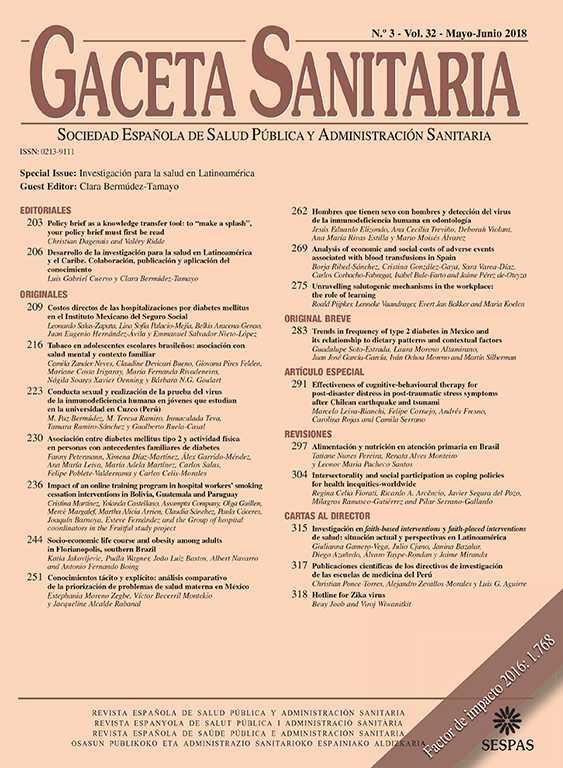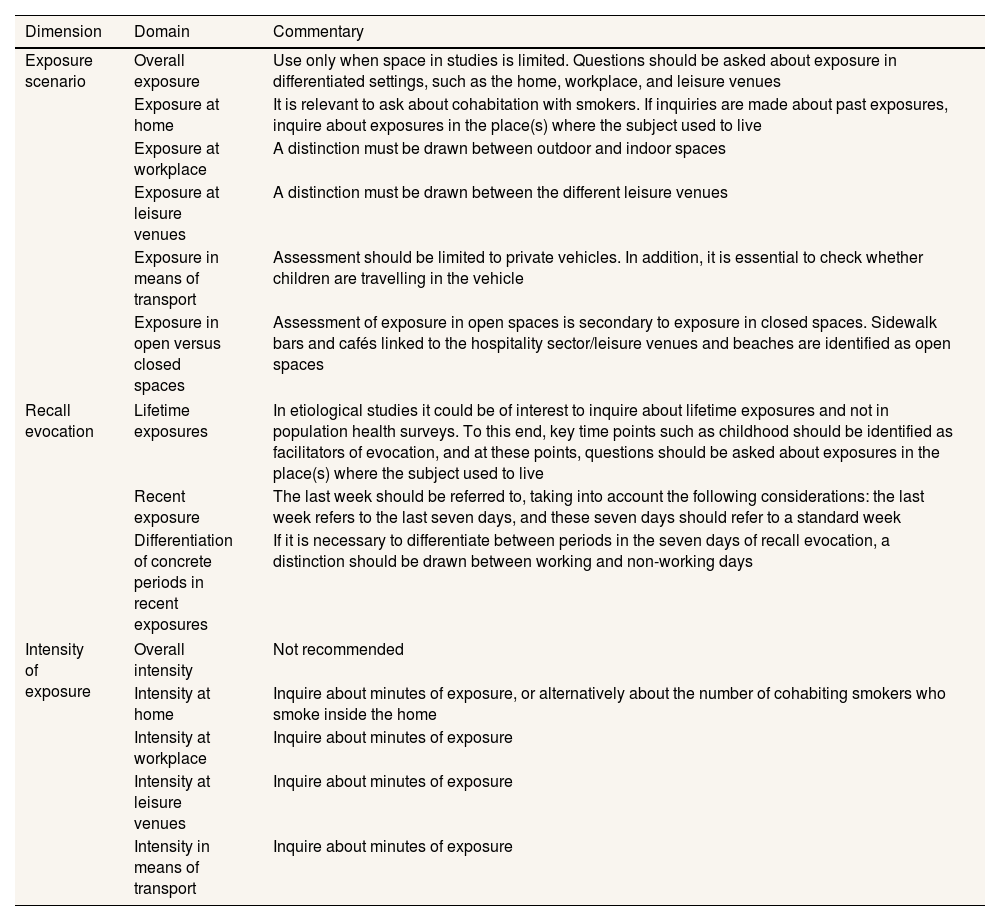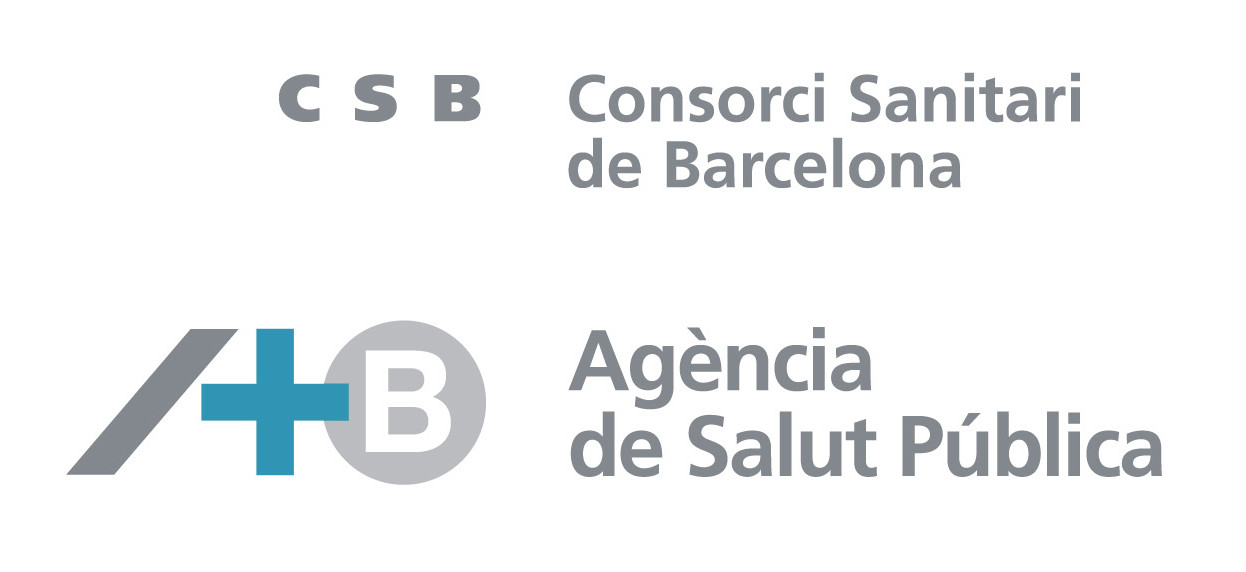To identify the dimensions and domains to be included in questionnaires when assessing self-reported secondhand tobacco smoke (SHS) exposure in etiological studies and in population health surveys.
MethodA qualitative study was conducted in two stages. In stage one, based on a Delphi methodology, 16 experts in tobacco epidemiology completed two questionnaires and attended a group session. In stage two, triangulation interviews were conducted with six experts from the Delphi study to provided in-depth reflection on the domains identified in stage one. The recorded transcriptions were analyzed using a thematic approach.
ResultsThe experts discussed the importance of assessing SHS exposure in specific scenarios, highlighting the home, workplace, leisure venues, and private transport. They discussed the importance of asking about cohabiting with smokers when assessing exposure at home. The experts stressed the importance of differentiating between leisure venues, by prioritizing closed over open spaces. In population-based health surveys, the experts recommended that the recall time should be recent, referring to the last seven days. In etiological studies, they suggested that lifetime exposures should be explored.
ConclusionsThis study marks the first step toward identifying the dimensions and domains for assessing self-reported SHS exposure. Question standardization when ascertaining SHS exposure is critical to permit cross study comparisons and to analyze trends in the evolution of SHS exposure.
Identificar las dimensiones y los dominios que deben incluirse en los cuestionarios para evaluar la exposición al humo ambiental de tabaco (HAT) autodeclarada en estudios etiológicos y en encuestas de salud poblacionales.
MétodoSe realizó un estudio cualitativo en dos etapas. En la primera, basada en un estudio Delphi, 16 expertos en epidemiología del tabaquismo completaron dos cuestionarios y participaron en una sesión grupal. En la segunda, se realizaron entrevistas triangulares con seis expertos del estudio Delphi para una reflexión más profunda sobre los dominios identificados en la primera etapa. Las transcripciones grabadas se analizaron utilizando un enfoque temático.
ResultadosLos expertos discutieron la importancia de evaluar la exposición al HAT en escenarios específicos, destacando el hogar, el lugar de trabajo, los lugares de ocio y el transporte privado. Además, consideraron la inclusión de preguntas sobre la convivencia con fumadores al evaluar la exposición en el hogar. Los expertos enfatizaron la importancia de diferenciar entre espacios de ocio, priorizando los cerrados sobre los abiertos. Para encuestas de salud poblacionales recomendaron que el tiempo de recuerdo fuera reciente, refiriéndose a los últimos 7 días. Para estudios etiológicos sugirieron explorar las exposiciones a lo largo de la vida.
ConclusionesEste estudio representa un primer paso para identificar las dimensiones y los dominios en la evaluación de la exposición al HAT autodeclarada. La estandarización de las preguntas es clave para facilitar la comparación entre estudios y analizar las tendencias en la evolución de la exposición al HAT.
Individuals’ perceptions about their exposure to secondhand tobacco smoke (SHS) are mainly assessed through self-report questionnaires. These questionnaires have been used to estimate SHS exposure as part of surveillance in population-based studies or clinical settings, and etiologic research.
Self-reported SHS exposure shows high variability in prevalence estimation based on the questions used.1–3 In some studies, the prevalence of exposure to SHS was ascertained by inquiring about exposure exclusively at home and at work.4 However, a review has found that recent studies have included a greater number of settings where exposure could occur, such as leisure venues.5 This variability is also observed when ascertaining intensity of exposure, which can be assessed in multiple ways such as through the number of smokers or the number of times a person is exposed per week to SHS.1,4,5 The lack of standardized, empirically validated questionnaires complicates the comparability and reliability of SHS prevalence of exposure estimates. Empirical validations, including psychometric analyses and pilot testing,6–8 are crucial.
As the first step, it is essential to identify the dimensions (understood as the main categories) and the domains (understood as the specific aspects) to be included in studies targeted at estimating the prevalence of self-reported SHS exposure. This information would make it possible to establish standardized questions to assess SHS exposure. The main objective of this study was to examine the domains, organized by dimensions, to be considered when formulating questions ascertaining self-reported SHS exposure, both in population health surveys and in etiologic studies.
MethodIn conducting this study, we adhered to the Standards for Reporting Qualitative Research guidelines.9 The study was carried out in two stages: the first was organized in three rounds and used Delphi methodology,10,11 and the second consisted of triangulated interviews (Fig. 1).12
Stage I: Delphi methodologyIn round 1, a panel of 30 experts were invited to participate by applying authoritative sampling by referencing their professional profiles and expertise. The panel was made up of 16 experts —eight men and eight women with different professional profiles who work in public health and tobacco epidemiology in different Autonomous Regions throughout Spain. All participants signed informed consent. Experts were contacted by email and 16 completed the three rounds. Round one, on March 3, 2023 and focused on defining the main dimensions the questionnaire would have to address (see Supplementary Material 1).
In round 2, a questionnaire containing 114 questions derived from different studies, and organized by the main dimensions identified in round 1, was compiled and e-mailed on March 13, 2023 to the panel of experts (see Supplementary Material 2). A score of 0 through 3 was set to rate questions most relevant to assessing SHS exposure. The following criteria were used to assess the degree of agreement: 1) rejection: at least 7 of the 16 experts considered the question not necessary (option 0); 2) acceptance of inclusion (crucial): at least 7 of the 16 experts considered the question of high priority (option 3); or c) medium priority: all other proposals (see Supplementary Material 2).
In round 3, crucial and medium priority questions were translated into domains, organized by dimensions and presented for discussion with the expert group on May 12, 2023 to refine the domains. Agreement was reached by consensus.
Stage 2: triangulation interviewsTo reflect on the results obtained in stage one, two triangulation interviews were conducted with six experts selected from the Delphi study. Of the six experts, three were experts in etiological studies (interviewed on July 19, 2023) and three in national or regional health surveys (interviewed on July 20, 2023). A 90-minute video call interview was conducted with each group (recorded subject to prior consent). The interviews were conducted by one of the researchers, with another team member acting as an external observer.
Data-processing and analysisThe interview transcripts were analyzed separately by two research team members (ABF, MPR) and two external collaborators who were experts in qualitative research. Thematic analysis was performed, with code trees generated individually. Differences in interpretation were settled by consensus among the four who participated in the analysis. The results of the Delphi study and the triangulation interviews were sent to the expert participants for review.
Verbatims from interviews have been translated.
ResultsDelphi studyThree main dimensions were identified: 1) exposure scenario, 2) recall evocation and 3) intensity of exposure; additionally, a cross-sectional dimension was identified: 4) language.
- 1)
Exposure scenario
The need to ask about overall exposure to SHS was emphasized, though in every case it was stated that this should be accompanied by an assessment of a specific setting in which exposure could take place. “Solely having information in general would greatly limit progress in tobacco control policies.”
Some experts were of the opinion that one should only ask about exposure in a specific setting. They argued that it is complicated to recall and quantify overall exposure. Since overall exposure can be ascertained based on specific exposure scenarios, overall exposure was not considered a crucial domain. “Ambiguity in the response to exposure in general prevents conclusions being drawn as regards to which exposure is being measured.”
Experts agreed on including home, workplace, and leisure venues as crucial domains for “exposure scenario”. In leisure, it was considered necessary to differentiate between concrete domains when it came to exposure at different hospitality venues, including bars, restaurants, clubs, discotheques, and concerts. It was likewise considered important to include domains entailing exposure at health centers, hospitals, and in private vehicles; and in the latter case, vehicles, to assess an “age domain” relating to the presence or absence of children and/or teenagers. Experts considered it mandatory to include a domain related to exposure occurring in open or closed spaces.
- 2)
Recall evocation
The domain reference period was set as “one week”. Evocation of the recall period generated some discussion about whether assessment of exposure should relate to the past seven days or to a standard week, with divided opinion. It was acknowledged that both approaches have advantages and disadvantages in terms of individual variability and accuracy of recall. Those who argued in favor of the past seven days justified their stance on the basis of preventing possible confounding in the interpretation of “last week”. The importance of considering a standard week was highlighted to prevent results from being influenced by specific events, such as vacations. Behavior patterns can differ between working days and public holidays, possibly affecting SHS exposure. Experts made the point that it would be necessary to define what was understood by a “working day” and a “public holiday or weekend” to ensure coherence and comprehensibility.
- 3)
Intensity of exposure
The intensity of exposure dimension focused on the domain “home”, since most of the experts stressed the importance of assessing cohabitation with smokers. Experts also indicated the importance of assessing the minutes of exposure to SHS in other settings (e.g. workplaces, leisure venues, and transport, public or private vehicles). Expert opinion centered on differences in assessment of the intensity of exposure by reference to the designated study objective (health surveys vs. etiological studies).
- 4)
Language
The experts proposed the use of clear, simple, precise terminology. For example, when smokers are interviewed it is essential to emphasize the distinction between their own smoke inhaled directly and the SHS they might be exposed to passively. The goal is to prevent confounding and ensure the term “exposure” is correctly understood. It is important that the terminology used in the questions is comprehensible to the target population. For example, the experts underscored the distinction between residing in or visiting a home when asking about home exposure.
Triangulation interviewsThe experts focused on 1) exposure scenario, 2) recall evocation, and 3) intensity of exposure.
- 1)
Exposure scenario
In etiological studies, experts queried the usefulness of asking about exposures in general when inquiring about past or recent exposures, since these could be associated with sporadic exposures and could, moreover, generate incongruities. “I really don’t see the purpose of a question as general as, ‘Have you been exposed at any time in your life?’, if we want to link this to health terms.” (Q3)
The experts underscored the fact that when assessing exposure in etiological studies, specific settings are required. Linked to this, they stressed the importance of including questions about exposure at home.
In health surveys, expert opinion was unanimous on the importance of including questions that differentiated assessment of exposure by setting, though they disagreed as to whether it was pertinent to include questions on general exposure. “… asking about exposure to tobacco smoke in general makes no sense at all. One has to separate by settings, and in certain settings, one has to separate by day, weekend or working day.” (Q3)
The counterargument applied to justify the inclusion of questions that assessed exposure in general was the limited space available in health surveys.
Expert opinion reflected on the importance of differentiating between open and closed spaces, especially in places that resemble closed spaces.
When it came to exposure on transport, a general question that covered overall exposure in transport would not seem appropriate. Expert opinion leaned toward assessing exposure exclusively in private transport. “If I had to choose, I’d go directly to private [transport] and try to record that.” (Q3)
Regarding exposure in cars, attention was drawn to the importance of asking about the presence of children and/or teenagers.
- 2)
Recall evocation
In etiological studies, added emphasis was given to the need to ascertain SHS exposure in the past, since this influences health events in the future. On this point, the experts differed in cases where exposure is assessed in relation to outcome variables with short or long latency periods. When inquiring about past periods, the experts judged it essential to choose significant time points enabling exposure to be linked to memorable persons or specific situations, such as childhood or adolescence. “I feel that if the goal is to picture your historical exposure, you could do this perfectly from childhood…and, above all, using key time points that are easy to associate.” (Q1)
In health surveys, the experts agreed that inquiring about the past was not pertinent. “I don’t really see [collecting data on exposure in] the past. No, in a health survey, no, because [interviewees] will get up and go.” (Q3)
They agreed that questions which assess SHS exposure in health surveys should evoke the present and point to assessment covering the past seven days or last week. “The present is a recent time period, and a week is a period, i.e., seven days, in which you can accurately remember what your exposure was like. But the same could be said of any other behavior and I think that the present can be considered.” (Q1)
This sparked a discussion about the possibility of evoking recall at different time points depending on the scenario being assessed. “No, there's’ no need for recall to be the same in each and every [scenario]. One can ask in different ways, in each of the places, I think.” (Q3) “(Your home is) a stable place in the sense that you live there every day, and so doing a recall of seven days seems to me unnecessary, but I would certainly inquire about [exposure] in the usual way.” (Q3)
Mention was made of the importance of distinguishing between working and non-working days in recall evocation, though in accordance with the place of exposure.
- 3)
Intensity of exposure
In etiological studies quantifying the intensity of SHS exposure was not considered relevant. “For health purposes, I feel that ultimately we are not as concerned about [quantifying the intensity of exposure] as telling the history, i.e., chronology.” (Q3)
In health surveys, experts felt that the assessment of intensity of exposure was complex and required prudence to avoid reporting incoherent information. “People find it difficult to answer them, and when [the data] are processed and refined you find many incoherencies and that it's complicated.” (Q1)
Experts indicated that when assessing the intensity of exposure in concrete settings such as the home or leisure venues, it makes sense to inquire about the time of exposure in minutes and/or hours, or, at home, about the number of smokers. In other settings, however, such as the workplace, job-specific differences may limit assessment of intensity. “How many persons usually smoke at home? For how long (hours) are you exposed? If you are exposed in leisure venues, for how long (hours) are you exposed?” (Q3) “[Referring to the workplace] Do you have any workmate who smokes so close to you that the tobacco smoke reaches you?” (Q3)
When it comes to asking about the smell, the experts pointed to the subjectivity of perception on the part of the interviewee and olfactory variability among people. “…the smell, no, not everybody starts from the same basis of being able to smell in the same way and with the same intensity.” (Q3)
The key items derived from the Delphi study and the triangulation interviews are summarized in table 1.
Aspects to consider in studies oriented to ascertain self-reported secondhand tobacco smoke exposure.
| Dimension | Domain | Commentary |
|---|---|---|
| Exposure scenario | Overall exposure | Use only when space in studies is limited. Questions should be asked about exposure in differentiated settings, such as the home, workplace, and leisure venues |
| Exposure at home | It is relevant to ask about cohabitation with smokers. If inquiries are made about past exposures, inquire about exposures in the place(s) where the subject used to live | |
| Exposure at workplace | A distinction must be drawn between outdoor and indoor spaces | |
| Exposure at leisure venues | A distinction must be drawn between the different leisure venues | |
| Exposure in means of transport | Assessment should be limited to private vehicles. In addition, it is essential to check whether children are travelling in the vehicle | |
| Exposure in open versus closed spaces | Assessment of exposure in open spaces is secondary to exposure in closed spaces. Sidewalk bars and cafés linked to the hospitality sector/leisure venues and beaches are identified as open spaces | |
| Recall evocation | Lifetime exposures | In etiological studies it could be of interest to inquire about lifetime exposures and not in population health surveys. To this end, key time points such as childhood should be identified as facilitators of evocation, and at these points, questions should be asked about exposures in the place(s) where the subject used to live |
| Recent exposure | The last week should be referred to, taking into account the following considerations: the last week refers to the last seven days, and these seven days should refer to a standard week | |
| Differentiation of concrete periods in recent exposures | If it is necessary to differentiate between periods in the seven days of recall evocation, a distinction should be drawn between working and non-working days | |
| Intensity of exposure | Overall intensity | Not recommended |
| Intensity at home | Inquire about minutes of exposure, or alternatively about the number of cohabiting smokers who smoke inside the home | |
| Intensity at workplace | Inquire about minutes of exposure | |
| Intensity at leisure venues | Inquire about minutes of exposure | |
| Intensity in means of transport | Inquire about minutes of exposure | |
In the assessment of self-reported SHS exposure, key dimensions and domains should be borne in mind for standardizing questions included in etiological studies and population health surveys. When assessing SHS exposure, the domains assessed should align with the goal of the assessment. The dimension “exposure scenario” should be assessed obtaining information on different domains, differentiating between open and closed spaces, such as the home, workplace, leisure venues, and private vehicles. In a research study conducted with the aim of studying the effects of exposure on health, the item “recall evocation” would refer to lifetime exposure to SHS, with key moments such as childhood used as facilitators of evocation. Expert opinion indicates that current exposure should refer to exposure in the last week, where the last week refers to the past seven days. In relation to the assessment of exposure intensity, the experts emphasize the importance of evaluating this dimension, despite its complexity. The experts recommend assessing intensity in terms of exposure time at home, workplace, leisure venues and transport. At home, they indicate that another alternative could be to assess cohabitation with smokers.
Recall bias associated with self-reporting of exposures has been a widely discussed topic.13,14 In relation to evoking exposure in etiological studies, it is important to note that recalling distant periods in time may incur recall bias. Experts recommend referring to key moments in the respondent's life and identifying places or settings where exposure was recurrent, such as the place of residence, to facilitate recall and mitigate this bias. Previous studies also suggest minimizing recall bias by asking about parental or spousal exposure, rather than recalling exposure from other sources that occurred years ago.15 For reporting recent exposure, it is proposed that only exposure in the past seven days is necessary, since this makes it possible to determine exposures that are stable over time, rather than specific exposures which, from a public health standpoint, would be of less interest. The definition of the place in which exposure occurs is also relevant. This study identifies interest in ascertaining exposures in places like the home, in which a significant part of a person's life is spent, whereas assessing exposure in settings in which the individual is present only sporadically is of little or no interest. Evaluation of exposure in closed spaces is fundamental, although open spaces, such as sidewalk bars and cafés are of interest when they resemble closed spaces.
This study represents another step toward agreement about which fundamental dimensions and domains are to be considered in the assessment of SHS exposure.3,8,16 To this end, the study included the opinion of experts on tobacco epidemiology, who conduct work on etiological research or on health determinants at a population level. Carrying out a study like this on the basis of two qualitative approaches, such as the Delphi methodology and triangulation interviews, has made it possible to objectively pinpoint aspects which had not been evaluated until now. Such aspects include the designated goal of the population health study undertaken, distinguishing multi- thematic studies, or the inclusion of the “age” domain linked to concrete exposures, such as those that can occur in private transport. The reflection conducted in stage two did not provide additional information regarding dimensions or domains, but it provided depth to the results.
One of the limitations of the study is that the participation of a limited number of experts may limit the diversity of perspectives and opinions; potentially compromising the results. Although the participants were mainly from institutions in Madrid and Catalonia, there were representatives from several autonomous communities, such as Aragon, Extremadura, and Galicia. The applicability of the domains may also be limited, as all the experts were from one country. Different legislative contexts may cause the results to vary. For example, in a study in Brazil and Portugal similar to this one, the areas to be assessed and the recall periods were different.17
The selection of participants for both the Delphi study and the triangulation interviews using authority sampling may have introduced selection bias. Although participants were chosen on the basis of their expertise in tobacco epidemiology, care was taken to ensure representation from different sectors, such as universities, public administration, and research institutes. In addition, those who participated in the Delphi study participated in the triangulation phase, potentially influencing the results. However, the triangulation interviews were intended to reflect on the Delphi study findings and did not alter the main results. The selection of participants for the triangulation interviews could have led to leadership bias if individuals in leadership positions were included in the same group as subordinates. To minimize this risk, participants in each group were selected from different institutions. Finally, it is important to note that empirical validation of the proposed domains and dimensions is still required. This process will be carried out as a subsequent step to this research.
ConclusionsLack of consensus when assessing self-reported SHS exposure in population studies hinders comparison of results between studies, and sometimes limits the power to assess how SHS exposure has varied in a given population.1,2 Unjustified changes in the questions or response categories in different editions of surveys makes it impossible to assess the impact of tobacco control laws. The dimensions and domains proposed in this study provide researchers and healthcare technicians with a tool that could help them reflect on how to assess SHS exposure, laying the foundation for the development of homogeneous questionnaires oriented to ascertain exposure to SHS.
Availability of databases and material for replicationThe derived data generated in this research will be shared on reasonable request to the corresponding author.
There is significant variability in the questions used to assess secondhand smoke (SHS) exposure. Previous reviews highlight the need for a standardized questionnaire to compare the results of SHS exposure prevalence between studies.
What does this study add to the literature?This study presents the recommendations reached in consensus by a group of tobacco experts on what to ask about SHS exposure. These recommendations have led to the identification of three main dimensions and their respective domains on which to focus in order to estimate the prevalence of SHS exposure.
What are the implications of the results?The findings of this study provide a framework for the development of a standardized questionnaire on SHS exposure, and offer researchers a valuable tool, providing guidance on how to assess SHS exposure.
Alberto Lana.
Transparency declarationThe corresponding author, on behalf of the other authors guarantee the accuracy, transparency and honesty of the data and information contained in the study, that no relevant information has been omitted and that all discrepancies between authors have been adequately resolved and described.
Authorship contributionsA. Blanco-Ferreiro: study data interpretation, writing the original draft, editing. J. Rey-Brandariz: conceptualization, study data interpretation and critical revision of the manuscript. J.S. Ahluwalia: conceptualization, study data interpretation and critical revision of the manuscript. L. Varela-Lema and I. Galán: study data interpretation and critical revision of the manuscript. M.I. Santiago-Pérez and F. Sureda: conceptualization, study data interpretation and critical revision of the manuscript. M. Fu, A. Schiaffino and M.J. López: conceptualization, data analysis, critical revision of the manuscript. X. Continente, C. Candal-Pedreira and E.M. Mahabee-Gittens: interpretation of study data and critical revision of the manuscript. M. Pérez-Ríos: conceptualization, obtaining funding, writing the original draft, critical revision and editing of the manuscript. All authors have read and approved the final manuscript.
AcknowledgmentsWe appreciate the collaboration of Esteve Fernández Muñoz, Juan Antonio Riesco Posada, Adriana Blanco Marquizo, Armando Peruga Urrea, Enrique Regidor, José María Martínez Sánchez, Andrés Zamorano Tapia, Ana Fernández Marcos and Regina Dalmau González-Gallaza.
FundingThis work was funded by the Instituto de Salud Carlos III [Reference: PI22/00727], and co-funded by the European Union.
Conflicts of interestThe authors declare that there are no conflicts of interest. Dr. Ahluwalia serves as a consultant and has equity in a start-up company, Qnovia. Qnovia is due to begin Phase I clinical trials to test a prescription nicotine replacement therapy through CEDR at the United States FDA. Dr. Ahluwalia has received sponsored funds for travel expenses as a speaker for the annual GTNF conferences from 2021-2024; as a speaker for the 2022 and 2024 Tobacco Science Research Conference; and as a speaker for the 2021-2023 Food and Drug Law Institute conferences.

















